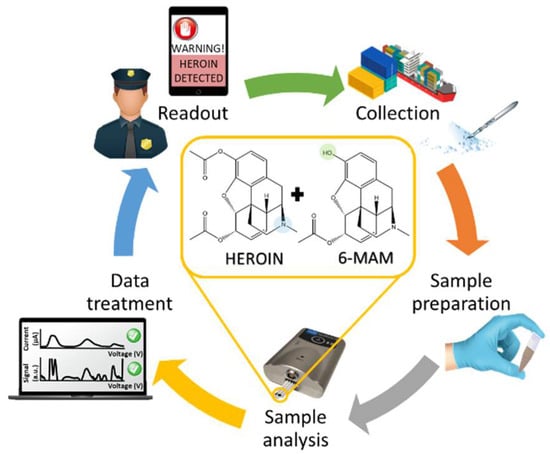The trafficking and consumption of drugs of abuse are global concerns that threaten social structures and jeopardizes the security of nations []. In particular, heroin use still accounts for the largest share of drug-related harm []. Thus, effective, rapid, low-cost, and selective analytical methods are vital to hinder drug trafficking and to prevent its availability on the drug market []. This way, chemical color tests and sophisticated spectroscopic instrumentation are often the first choice. However, significant drawbacks should be considered, e.g. the inaccuracy of the color tests or the high cost and low portability of the spectroscopic devices. Interestingly, electrochemical sensors have proven to be the solution for the on-site detection of illicit drugs due to their balance between affordability and analytical performance [,].
The present study reports on an improved method for the on-site profiling of heroin. The principle is based on two-peak recognition, i.e., from heroin and its main metabolite 6-monoacetylmorphine (6-MAM) at a basic pH (Figure 1). Unfortunately, paracetamol, which is the most encountered cutting agent in heroin seizures, completely overlaps the 6-MAM peak at unmodified electrodes, thus hindering its potential use to selectively detect heroin. As a result, a rapid and smart electrochemical pretreatment is presented to overcome this masking phenomena. Moreover, a customized script is integrated to enhance peak-to-peak separation and enlighten the full composition of heroin samples.
Overall, the proposed strategy paves the way to the rapid, user-friendly, and low-cost on-site detection of heroin in real scenarios by law enforcement officers through: (i) analysis of suspicious powders on the street, and (ii) rapid screening of cargos in border settings (e.g., airports and harbors).
Supplementary Materials
The following poster is available online at: https://www.mdpi.com/article/10.3390/ecsa-9-13222/s1.
Author Contributions
Conceptualization, N.F.M. and M.P.; methodology, N.F.M. and M.P.; investigation, N.F.M., V.B. and G.N.; resources, K.D.W. and F.V.D.; data curation, N.F.M.; writing—original draft preparation, N.F.M.; writing—review and editing, M.P., V.B. and K.D.W.; supervision, K.D.W.; project administration, K.D.W.; funding acquisition, K.D.W. All authors have read and agreed to the published version of the manuscript.
Funding
This project has received funding from the European Union’s Horizon 2020 research and innovation programme under grant agreement No 833787, BorderSens.
Conflicts of Interest
The authors declare no competing financial interest.
References
- EU Drug Markets Report 2020; European Monitoring Centre for Drugs and Drug Addiction: Lisbon, Portugal, 2020.
- EU Drug Markets Report 2019; European Monitoring Centre for Drugs and Drug Addiction: Lisbon, Portugal, 2019.
- De Araujo, W.R.; Cardoso, T.M.G.; da Rocha, R.G.; Santana, M.H.P.; Muñoz, R.A.A.; Richter, E.M.; Paixão, T.R.L.C.; Coltro, W.K.T. Portable analytical platforms for forensic chemistry: A review. Anal. Chim. Acta. 2018, 1034, 1. [Google Scholar] [CrossRef] [PubMed]
- Teymourian, H.; Parrilla, M.; Sempionatto, J.R.; Montiel, N.F.; Barfidokht, A.; van Echelpoel, R.; de Wael, K.; Wang, J. Wearable Electrochemical Sensors for the Monitoring and Screening of Drugs. ACS Sens. 2020, 5, 2679. [Google Scholar] [CrossRef] [PubMed]
- Truta, F.; Florea, A.; Cernat, A.; Tertis, M.; Hosu, O.; de Wael, K.; Cristea, C. Tackling the Problem of Sensing Commonly Abused Drugs Through Nanomaterials and (Bio)Recognition Approaches. Front. Chem. 2020, 8. [Google Scholar] [CrossRef] [PubMed]
Publisher’s Note: MDPI stays neutral with regard to jurisdictional claims in published maps and institutional affiliations. |
© 2022 by the authors. Licensee MDPI, Basel, Switzerland. This article is an open access article distributed under the terms and conditions of the Creative Commons Attribution (CC BY) license (https://creativecommons.org/licenses/by/4.0/).
